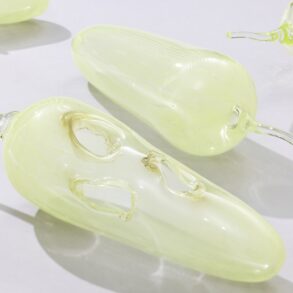Art
Josie Thaddeus-Johns
Dec 18, 2023 5:05PM
Paulina Olowska, Seductress, 2020. Courtesy of Fondazione Sandretto Re Rebaudengo,
Paulina Olowska, The Revenge of the Wise Woman, 2011. Courtesy of Fondazione Sandretto Re Rebaudengo,
Paulina Olowska has spent her career as an artist centering women, and their perspectives, in a world that regards them as objects. Women feature across her fashion-inspired paintings, which often use magazine photoshoots as source material. Her portraits often show her female subjects in sharp focus as the world around them dissolves into painterly, blurred abstraction. This body of work has earned her art world notoriety: In 2022, the artist joined the roster of Pace Gallery, which is currently showing her debut solo show, “Squelchy Garden Mules and Mamunas,” at its London location through January 6, 2024.
Olowska’s Pace debut is running concurrently with an expansive show, “Visual Persuasion,” at the Fondazione Sandretto Re Rebaudengo in Turin, Italy, creating a major moment for the artist. In “Visual Persuasion,” the artist has moved into curating, presenting a show of her own work—both new commissions and pieces belonging to the Fondazione’s collection—alongside historical works by other artists that speak to the commodification and liberation of women’s bodies. Installation, videos, and even performances supplement lush, wall-based works like Olowska’s Seductress (2020), which portrays a couple mid-flirtation: an elegant woman holding her hand out to be kissed by an adoring man.
Paulina Olowska, Silver Foam, 2018. Courtesy of Fondazione Sandretto Re Rebaudengo,
Advertisement
“Visual Persuasion,” which is on view through February 25, 2024, sprawls across the Fondazione’s entire exhibition space—a rarity for the museum, as the show’s curator Irene Calderoni (who is also chief curator of the Fondazione Sandretto Re Rebaudengo ) explained in a walkthrough. A 1970s visual aesthetic recurs in many of the works: Neon lights, allusions to soft-porn cinema, and go-go boots, for example, all feature. Though Olowska was only born in 1976, she cited the decade as the source of her “visual education,” she explained in an interview with Artsy. “I just love it, because it had a spirit of freedom,” she said.
That freedom seems to be the artist’s north star in an exhibition that considers the possibilities and limitations of depicting female sexuality. In the process of exploring these ideas, the artist shines the spotlight on several artists whose works are less well-known than hers. Maja Berezowska, for example, was an early 20th-century Polish painter whose erotic works on paper frequently depict women in charge of their own pleasure. In the exhibition, her work appears in dialogue with several large paintings by Olowska featuring images repurposed from Viva, an erotic magazine for women that was published between 1973 and 1980.
In these works, fleshy moments of pleasure are shown at a large scale, blurred and in soft focus. Drawings of nudes are scratched over the top of the images in black paint, along with verses from poems by Maria Pawlikowska Jasnorewska (sometimes known as “the Polish Sappho”). But while Viva—which ran serious criticism, and hired Anna Wintour as its fashion editor—was aimed at women, it was published and marketed by men. These wall-spanning monuments to women’s sexuality try to capture the joy of intimacy from a female perspective, while simultaneously critiquing the aestheticization of women’s pleasure by male-oriented society.
This embrace of contradictions is evidenced through the pairing of Olowska’s smoothly contoured feminine sexual appeal with the gross, monstrous aspects of the flesh explored by other artists in the exhibition. In the same room as the series of Viva-inspired paintings is Berlinde de Bruyckere’s sculpture La Femme Sans Tête (2004), a wax sculpture resembling a misshapen human body with layers of skin and flesh drooping into one another. Also sharing the space is Nice Tits, a 2011 sculpture by Sarah Lucas in which breast-like protrusions made of stuffed nylon tights extrude through a metal grid, creating a striking, globular mass.
Paulina Olowska, installation view of “Visual Persuasion” at Fondazione Sandretto Re Rebaudengo, 2023. Photo by Isabella Castellano. Courtesy of Fondazione Sandretto Re Rebaudengo.
Neon is another theme in the show, which dedicates an entire corridor to signage. The medium has a particular resonance for the artist, who grew up with socialist versions of brightly lit signs in Poland, then part of the Eastern Bloc. “They were made not to advertise, but to state ideas,” she said, recalling charming examples of signs from her childhood with messages like “let’s meet in the cinema.” Other enticing neon signs, she said, spread public service announcements about the importance of handwashing or dental hygiene, a stark contrast to the commercial usages that neon has in the West. For Olowska, neon and women’s bodies are used in similar ways in advertising—as hollow, commercialized emblems of desire.
With its inclusion of works made over the last 50 years, as well as Olowska’s own use of ’70s aesthetics, “Visual Persuasion” could feel like a nostalgia trip. But the artist explained she hoped to use the lessons of history to build alternative visions of eroticism, rather than simply accepting the status quo. “What we have now in this industry doesn’t interest me so much,” she said of depictions of sexuality in contemporary art. “This show is really about: How are we going to create eroticism? How do we want to create in the future? So I thought, ‘Let’s look in the past.’”
Paulina Olowska, installation view of “Visual Persuasion” at Fondazione Sandretto Re Rebaudengo, 2023. Photo by Isabella Castellano. Courtesy of Fondazione Sandretto Re Rebaudengo.
To this end, the artist makes repeated claims for female ownership of desire throughout the show, drawing inspiration from 1970s porno chic, particularly as typified by the French movie Emmanuelle (1974). At the opening of the show, Olowska’s painting Loveress (2020) recasts the infamously explicit film’s poster in paint. Though the movie’s skirting of disturbing themes isn’t without controversy, Olowska sees a sense of “emancipation” in its portrayal of the eponymous character making a journey of pleasure and sexual exploration through an expat underworld in Bangkok. This attention-grabbing painting by Olowska is paired with a work by Sylvie Fleury: Egoiste (1996), which renders the work’s title—translating to “self-centered”—in white neon. For Olowska, it seems, the curatorial implication is clear: If desire is selfish, so be it.
Josie Thaddeus-Johns
Josie Thaddeus-Johns is an Editor at Artsy.
This post was originally published on this site be sure to check out more of their content




